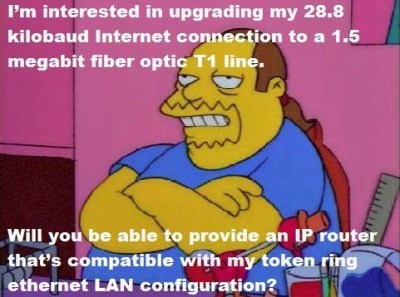
Wanna be hackers? Code crackers? Slackers. If the vintage computing community ever choose an official anthem, count my vote for It’s All About The Pentiums by “Weird Al” Yankovic. More than twenty years after its release, this track and its music video (with Drew Carey!) are still just as enjoyable as they ever were, with the track’s stinging barbs and computing references somehow only improving over time.
In the track, Weird Al takes on the role of ‘king of the nerds’ with his rock star-esque portrayal of a nameless personal computing legend, someone who de-fragments their hard drive “for thrills” and upgrades their system “at least twice a day”. The lyrics are a real goldmine for anyone that is a fan of 1990s computing, but what stands out to me is the absurd hardware that Weird Al’s character claims to own.
Absurd by 1990s standards, maybe. Not so much anymore. Even with the ongoing chip shortage and other logistic shortfalls, everyone now has the opportunity to start cruising cyberspace like Weird Al and truly become the “king of the spreadsheets”. However, would it have even been possible to reach these lofty computing goals at the time of the parody’s release? Let’s check out both of these threads.
Processor and Memory
At the time of recording It’s All About The Pentiums, the Intel Pentium III was dominating the home computer market, specifically the ‘Katmai’ variant, advertised with clock speeds ranging from 450 MHz to 600 MHz. At the same time, the Pentium III Xeon was also available with the ‘Tanner’ core. Even with roughly the same clock speeds, the Xeon Pentium III variants would have pipped the home-oriented Pentium III, and it’s safe to assume that Weird Al’s PC-obsessed doppelganger would have opted for the server-class CPU. After all, two megabytes of L2 cache doesn’t come cheap! Money is clearly no obstacle when he’s calling Bill ‘Money’ Gates for tech support.

Intel still markets Pentium-branded processors, and their existence can be tentatively traced back through to the original Pentium cores and P6 microarchitecture from the 90s, including the Pentium III. These are budget x86-64 processors branded with the Pentium label, so they count. The new breed of Pentiums are obviously going to eclipse its 90s ancestors due to clock speed and architecture improvements, as is clear in these benchmarks.
More importantly, these new Pentium-branded processors are able to realize Weird Al’s still hefty requirement for one-hundred gigabytes of RAM. The original Pentium processors were based on 32-bit computing standards, and therefore only supported a maximum of four gigabytes of RAM. The new breed of ‘Pentium’ processors support 64-bit instructions, and each processor can easily address up to 128 GB of physical memory.
Physical Address Extension (PAE) was available on Windows 2000 Datacentre Server, which increased the amount of addressable RAM for a 32-bit processor to a gargantuan 32 GB, but this is still a far cry from the 100 GB requirement — not to mention that Datacentre Server wasn’t released until 2000, and was only sold to large businesses. PAE was introduced to the Linux kernel in 1999, but still wouldn’t have been able to support 100 GB of RAM. Dang.
If Weird Al really wanted more than 4 GB of RAM and needed to use Pentium processors, he could have built his own supercomputer. At the time, Cornell’s Wintel-based AC3 Velocity Cluster technically supported hundreds of gigabytes of RAM across its dozens of nodes. I feel like Weird Al’s character would absolutely be the type to build his own Pentium-powered computing cluster, so we’ll call this plausible.
As mentioned, putting together such a system today is relatively simple, even by ‘home’ standards. There are dozens of possible configurations using a Pentium-class processor, 128 GB of RAM and a compatible motherboard. While pairing such an underwhelming CPU with a (still) very large amount of RAM would be ridiculous, it’s absolutely possible. It’s even reasonably affordable.
Input/Output
Weird Al mentions he “installed a T1 line” to his house. With data rates at a blazing 1.554 megabits per second, this was one of the fastest ways to connect to the Internet in the late 90s, and was available over twisted-pair copper or fiber optic cabling. Weird Al wasn’t the only one that understood the virtues of a T1 line – even Comic

Book Guy on the Simpsons knew he had to have it, despite the eye-watering costs.
While T1 connections have been largely displaced by modern, and far cheaper, fixed broadband and wireless, some businesses still opt for the T1 standard due to its famed reliability. So while it’s definitely, probably, maybe still possible to hook up a T1 line at home, you would be far better to use literally any modern alternative, including cellular.
The lyrics also speak of a monitor “forty inches wide”, which would have been absurdly large for the time. Most CRT-based monitors of the time period were available in sizes up to 21” or thereabouts. One of the largest CRTs ever produced was the Sony PVM-4300, which boasted an incredible 43” of screen real estate. However, this immense screen size required a similarly immense table, or indeed floor. Even the service manual warns “make sure the floor is strong enough”, as the 4300 weighs in at over 440 lb (over 200 kg).
Released in 1990, it’s entirely possible that Weird Al imported one of these floor-shattering CRTs from Japan for his PC battlestation , however its utility as a computer monitor was probably questionable, given it was a video monitor built around the television standards. It goes without saying that LED and LCD technology has brought such large computer monitors well within the realm of possibility, and many examples are presently available. As an added bonus, you don’t need a forklift to move it around.
Finally for this section, I think we all know what a ‘mizouse’ is. Let’s all agree to call it a ‘mizouse’ from now on. No? Just me?
The Savage Computing Burns
To wrap up this rambling retrospective, I’ll briefly touch on some of the jokes that Weird Al cracks about inferior computing setups during Pentiums.
Waxing your modem?

What, you’ve never waxed your modem before? As previously mentioned, Weird Al is set with his T1 line, which leaves the “dumbest newbies” desperately applying wax to their modems to try “make it go faster”. I’m almost certain that wax has no effect on modem speeds. Almost. Make sure to let Hackaday know via the tip line if you have heard differently.
You’re using a 286? Don’t make me laugh. Windows boots up in what, a day and a half?
‘Well, actually,’ this burn doesn’t really translate. The 80286 processor was more than suitable for running Windows 3.1, however Windows 95 and later versions were not compatible with the 286 due to limitations of the processor architecture. If it had been compatible, it may well have taken an unreasonably long time to boot.
Windows 95 was best paired with Pentium-class processors, however it was compatible with the 386SX CPU and faster. It was also possible to install Windows 98 on a 386 processor using an undocumented switch during installation, which forced the installer to ignore the minimum processor requirements.
So maybe Weird Al just misspoke, and he should have referred to the more compatible, but still frighteningly out-of-date, 386 processor, just so the punchline landed more firmly. Or, is it possible that I’m just looking at all this too closely?
Back up your whole hard drive on a floppy diskette?
This one can be unpacked quite a bit. The burn was probably referring to the ubiquitous 3.5″ 1.44 MB floppy diskette, so we’ll base our assumptions there for now. In the 1980s, hard disk drive sizes were typically in the order of 10 MB to 20 MB, with capacities steadily increasing into the 1990s and beyond. By 1999, most hard disk drives would have stored multiple gigabytes, so it’s hard to imagine a scenario where anyone would be backing up their entire hard drive to a floppy diskette at any point in time.
Or, is it? Fans of MS-DOS were still hanging on throughout the 90s and even beyond, so it’s not unreasonable to think that some luddite was still getting by with a bare-bones installation of DOS with a few mission-critical applications on their AT or XT-class computer. Without the bloat of Windows, this burn actually makes a lot of sense — after all, DOS was originally designed to be installed and booted from a floppy disk, with user applications usually stored and run from the second floppy drive. Even Windows 3.1 can be hacked to boot and run entirely from a floppy diskette.
Then there is the LS-120 SuperDisk, which for a time looked like it would be the ultimate replacement for the traditional floppy disk format. With a capacity of 120 MB, you’re still not going to fit a Windows 95 installation plus applications onto a diskette, but earlier versions of Windows plus applications, documents and games could absolutely fit onto one of these disks.
There’s also LS-240 drives and Zip Disk technology. But, let’s not go there, otherwise this article is going to go on forever.
You’re the biggest joke on the Internet
Not much to say here, just that this hurts way more in 2021 than it did in 1999. Leave your friendly comments below!
0 Commentaires